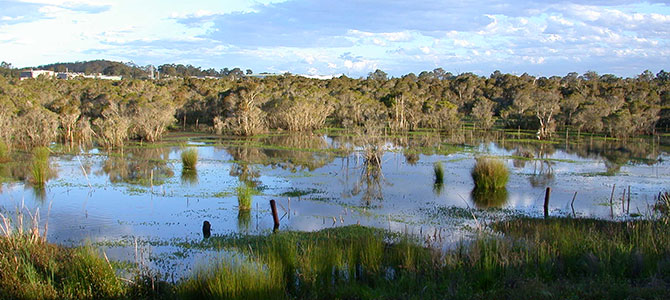Significant steps have been taken to achieve the permanent protection of Porters Creek Wetland, the largest fresh water wetland on the Central Coast.
Mayor, Jane Smith, has made the permanent protection of the Porters Creek Wetlands one of her major goals as the first Mayor of the amalgamated Council. She said it was a “critical part of the bigger picture for that area” in terms of how surrounding land could be developed to create employment. “The former Wyong Council, for some 20 years, and different people, have been recognising its value and it needs protection, and they just haven’t been able to deliver what is required,” she said. “So I am really pleased that we are making progress.”
She said the report considered at the Monday, December 10, Central Coast Council meeting put in place the need to reclassify the SEPP14 (protected) wetland from Operational land to Community land, to ensure it could not be sold off. “I think that is an important first step. “There have been numerous studies of the wetlands and part of the resolution was to pull that information together and turn it into a proposal and a case for why it needs stronger protection. When introducing her motion to the meeting, which was seconded by, Clr Kyle MacGregor, Mayor Smith said she wished to see Council engage a consultant with wetland expertise, to initiate biodiversity stewardship agreement and investigate whether it could be declared as a wetland of international significance. She said she wanted Council to liaise with National Parks and prepare a submission and to look at what planning clauses might be considered for an LEP or DCP to minimise impacts.
“The significant part, in my view, about Porters Creek Wetland, is that it is the largest fresh water wetland on the Central Coast. “Just by nature of the size and role, it is important for Tuggerah Lake, for the run off and water quality going into Tuggerah lakes. “In terms of flora and fauna, it has threatened species and endangered ecological communities.” According to the staff report presented to the meeting, Porters Creek Wetland is significant because of its ecology and its impact on improving downstream water quality from its large catchment area. Work on the December 10 resolution started in March, when Council unanimously resolved to request the CEO to arrange a meeting with the Office of Environment and Heritage, Department of Planning and other stakeholders to identify mechanisms to permanently protect Porters Creek Wetland.
The meeting was held in May, and several mechanisms to permanently protect Porters Creek Wetland were identified and discussed. Of seven options considered, a Biodiversity Stewardship Agreement was considered to be a strong mechanism to protect the wetland. “The next strongest are the existing planning instruments, State and Local, which are already in place,” the staff report said. “A Biodiversity Stewardship Agreement can provide offsets for development opportunities elsewhere, and will support the creation of an income stream to fund the ongoing management of biodiversity in Porters Creek wetland,” it said. “Landowners, including Council, may consider entering into a voluntary Biodiversity Stewardship Agreement (BSA) on any parcel of land under the NSW Biodiversity Conservation Act 2016.
“There are provisions within the agreement for “in-perpetuity conservation. “Council would be able to sell credits and receive an annual management payment to service the BSA. “This can provide permanent protection for the management of biodiversity and allow for the creation of biodiversity credits for sale. “The resulting stewardship site generates biodiversity credits which represent the expected improvement in biodiversity that will result from the protection and management of the site. “A landholder (Council) can sell the biodiversity credits to a developer, the NSW Biodiversity Conservation Trust, or other interested parties. “Once credits are sold, the site needs to be maintained in perpetuity. “The potential credit status of the Porters Creek wetland land parcels would need to be assessed. “A BSA is registered on the land title.
“When land that includes a BSA is sold, then the new owner takes over the obligations of the stewardship agreement and in return receives payments from the Biodiversity Stewardship Payments Fund.” Another strategy would be to donate the land to National Parks. “NPWS would assess the value for use as a national Park, its diversity and cultural heritage values, recreational opportunities, park management benefits and economic impacts. “The land would need to align with the NSW National Parks System Directions Statement. “This is a strong level of protection. “The national Environment Protection and Biodiversity Conservation Act 1999 is the legal framework to protect and manage nationally and internationally important flora, fauna, ecological communities and heritage places.
“Under the Act, the Federal Environment Minister may declare a specified wetland to be of international importance (often called ‘Ramsar’ wetlands after the international treaty under which such wetlands are listed). “There are presently 12 Ramsar wetland sites in NSW, the closest being Hunter Estuary Wetlands, and Myall Lakes. “The nomination process would include comments from the State. “The process is long [and] a declaration would be unlikely.
Source: Interview, Dec 11 Jane Smith, Central Coast Council Agenda item 5.8, Dec 10 Central Coast Council ordinary meeting Jackie Pearson, journalist



